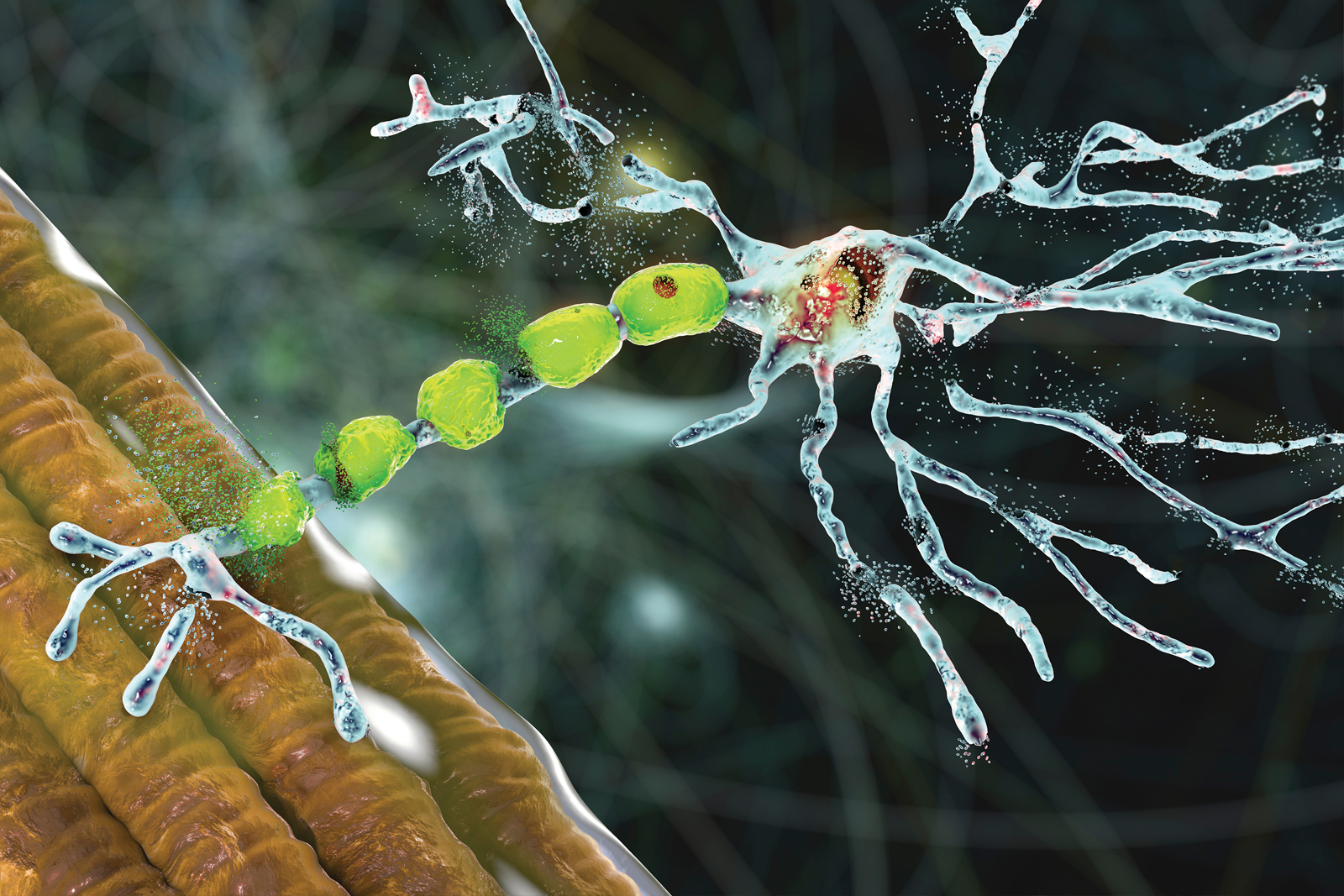My name is Antonio and I suffer from spinal muscular atrophy (SMA, for friends). My life expectancy was only a few years when I was born, almost half a century ago. And all because I “got” a rare, neurodegenerative disease, which is among the genetic diseases with the highest associated mortality.
What happens, simply put, is that my motor neurons (the «cables» that link the spinal cord to the muscles) gradually degenerate and end up dying. This has kept me in a wheelchair for most of my life. And over time, the involvement of the respiratory muscles can lead to the fatal outcome.
But since I am also a scientist, I must add that I have discovered that SMA is the most beautiful disease in the world… at a molecular level.
How does spinal muscular atrophy occur?
SMA is a genetic disease caused by the mutation or loss of a gene called SMN1. If our mother and father have a mutated copy (one of two copies each), and we are unlucky enough to inherit these two defective copies, we are likely to get SMA.
This gene contains the information to guide the construction of a protein called SMN. Its name comes from the suggestive acronym “survival of motor neuron,” and it plays very important roles in our body. In fact, without SMNs, there is no survival of motor neurons, and no possibility of life itself. This is because these cells are essential for carrying out muscle movements, including those of the diaphragm or pharynx, which allow us to breathe and eat.
So how do SMA patients survive? Because it turns out that there is a second gene in the human genome, called SMN2, which also allows us to build the same SMN protein. SMN1 and SMN2 are almost identical, but SMN2 differs in five of the more than 40,000 letters or nucleotides of which these genes are composed.
The existence of virtually identical genes is very rare in the human genome. In fact, SMN2 does not even exist in other animals: it is unique to our species.
A lifesaver
These minimal differences between the two genes mean that the SMN protein from SMN2 is only produced in its entirety in 10% of cases. In principle, this would be insufficient for long-term survival, but it happens that humans can have from zero to more than 10 copies of the SMN2 gene.
Doing a quick calculation, if we have ten copies, and each copy produces 10% of SMN, we will generate 100% of the SMN protein we need. But what happens if we have fewer copies of SMN2, say five? Well, only 50% of the required SMN is made up.
So, in general, those who lack the SMN1 gene and have only one copy of SMN2 have a severe case of the disease, with more rapid progression (type I). Those with two copies have a milder case (type II). Finally, with three or more copies we have an even milder case (type III) and the chances of living longer are increased.
Given this reality, we can conclude that evolution “invented” the copy of SMN1 in humans to have a lifesaver in the case of losing the main gene. Beautiful, isn’t it?
Extortionately expensive treatments
Knowing all we know, how can we cure SMA? If SMN1 is missing or the gene is mutated, as with other genetic diseases, there is no choice but to replace the missing gene. In fact, although it sounds like science fiction, this substitution is already underway. In 2019, the drug Zolgensma was approved, which allows the SMN1 gene to be introduced via a virus that carries it directly to the motor neurons.
But the real beauty of SMA is that, because SMN2 exists, we can use other, more original approaches. Let’s think about it for a moment: if we can figure out what makes SMN2 produce only 10% of the full SMN protein and fix the problem so that the percentage is higher, we can compensate for the lack of SMN1.
And that’s what the first treatment approved in 2016 for SMA, Nusinersen, does, as well as another one greenlit in 2020, Risdiplam.
What these treatments achieve seems really easy to do if we rely on a bit of basic biology. In the case of Zolgensma, it’s all about getting the SMN1 gene intact into the motor neurons, which is now called gene therapy. And in the case of the other two treatments, the challenge is to get something to stick to the region that differentiates SMN1 and SMN2, to turn the latter into the former.
But the difficulty of making this work, and also bringing it to the rare disease market, means that both treatments are among the most expensive in the world. Zolgensma costs no less than…. two million euros per dose! That makes it the most expensive disease in the world. Fortunately, only one dose is needed. In the case of Nusinersen and Risdiplam, it would cost between 400,000 and 800,000 euros per year (and, of course, per patient).
Why these sky-high prices? We will never know. Pharmaceutical companies usually negotiate the price of the drug independently in each country and with zero transparency. This leads them to consider the drug as a commodity, the price of which is not necessarily linked to its development and production cost. Rather, it is the price one is willing to pay for the life and well-being of patients in every part of the world.
By the way, none of the three drugs cures. They only slow down the progression of the disease—which is no small thing.
Future for SMA and other rare diseases
What will happen in the future with these rare disease treatments? Well, obviously, the market will eventually drive prices down. Treatments such as gene therapy have already been used for other diseases, and will undoubtedly continue to appear and, more importantly, to be perfected. Ultimately, the universality of their use will favor lower prices.
On the other hand, we can pin our hopes on drug repurposing, i.e. the use of existing drugs for other diseases. This has the enormous advantage of greatly reducing costs and shortening research times.
In conclusion, it is indisputable that SMA is a devastating disease, and that SMA patients will always have the right to complain about the bad luck we were born with. But at least I hope I have shown that this disease has a special charm at the molecular level which, for those of us who suffer from it, also gives us a certain right to call it “the most beautiful disease in the world.”
Antonio J. Pérez Pulido is an SMA patient and co-project leader.














